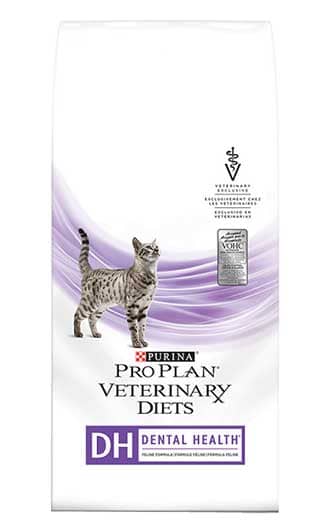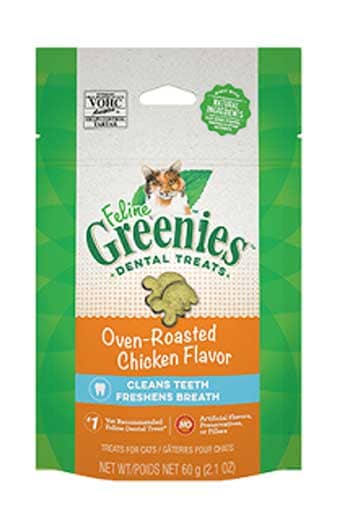Dental homecare is necessary to maintain good oral health. Professional scaling and polishing of teeth, although highly effective, is not sufficient to keep your pet’s mouth healthy on a long-term basis as plaque can form in 24 hours, calculus in 3 days, and gingivitis can start in 2 weeks.
Dental homecare is divided into active methods (tooth brushing and wipes) and passive (dental diets, chews and water additives). Without a doubt, the most effective methods are active, however the compliance of owners performing this type of hygiene is low (1%), making passive methods superior simply due to the fact that they are actually performed.
There are numerous products available, but only a few have scientific evidence that they produce any health benefit. The Veterinary Oral Health Council (VOHC) lists products that meet standards of effectiveness in controlling dental plaque and calculus in dogs and cats (www.vohc.org).
We have summarized the VOHC-approved dental homecare products that we recommend.
Dental Diets: Purina Pro Plan Veterinary Diets DH Dental Health; Hills Prescription Diet t/d

There is a misconception that simply feeding a kibbled diet will protect the teeth from dental disease. Consider what it would be like to replace brushing your own teeth with eating crunchy foods and you can see how ineffective this method would be. When it comes to pet foods, much of the kibble is swallowed whole and not chewed at all.
Dental diets use several techniques to help reduce plaque and tartar. The first is that the kibbles are very large which means the pet must chew them before swallowing them. These diets are high in fiber which means the kibbles do not shatter when chewed but instead the tooth sinks into the kibble allowing plaque to be essentially scrubbed away. It is important to realize that these diets are helpful only in cleaning the molars and premolars (the chewing teeth) and do not help the canines or incisors.
Dental Chews: VEGGIEDENT for dogs; Greenies Dental Treats for cats
The daily addition of tested dental chews was proven to reduce plaque and calculus accumulation as well as gingivitis and halitosis (bad breath). The main beneficial effect of these products is achieved by the chewing action which allows tartar and plaque to be scraped away. The action of chewing stimulates saliva production which when combined with the mechanical forces applied to the dental surfaces, helps flush away debris, food remnants, and helps to detach deposits. It should be noted that it is unlikely for a dental chew to improve oral health without a proper and regular professional dental cleaning.
Dental chews are most effective on the chewing (back) teeth and should complement active homecare (tooth brushing) which is most effective on front teeth that are easier to access.


The vegetable-based dental chew VEGGIEDENT has been shown to be safe,
soluble in vitro by digestive enzymes, palatable, and efficient in reducing bad
breath according to owners. The lack of common food allergens and animal
derivatives in this veterinary chew also benefits patients who suffer from
food intolerances or allergies.
It is NEVER recommended to give your pet bones, cow hooves, antlers,
nylon toys or other similar hard objects due to the risk of fracturing the tooth.
Water additives: Healthy Mouth; Vetradent
Added to drinking water for plaque control in cats and dogs.
Healthy Mouth: Contains natural ingredients that prevents the accumulation of bacteria in the mouth, thereby reducing plaque and keeping the mouth cleaner. The formulation also coats the inside of the mouth to provide continuous protection against the accumulation of bacteria. A natural enzyme, papain, reduces the build up of proteins in the mouth, and zinc gluconate operates as an antibacterial agent. The combination of these two ingredients effectively reduces bacterial proliferation.


Vetradent: When Vetradent enters the pet’s mouth, its binding agents immediately attach to the magnesium, calcium and iron, and wash them away – effectively removing the bacteria’s food source and weakening the tartar. Without this food source the bacteria have nothing to live on and colonies become weak. Eventually the layers of plaque and tartar buildup begin to soften. The tartar can then easily flake and break off.
Tooth Brushing and Tooth Paste:
C.E.T. Enzymatic Toothpaste Studies have shown that brushing three times a week was adequate to maintain healthy teeth and gums but daily brushing was needed to control existing gingivitis. Tooth brushes made specifically for pets will better fit inside their mouths. Finger tooth brushes are available for smaller pets.

Proper brushing technique:
Toothbrush bristles should be placed at a 45-degree angle where the gum and teeth meet. Using a gentle oval pattern and covering three to four teeth at a time, the bristles should be moved around the teeth. Ten short oval motions should be completed before moving the toothbrush to a new location in the mouth. The outside upper teeth do the most chewing and should get more attention.
Tooth brushing do’s and don’ts
- Don’t use a human toothpaste on your pet.
- Do use a toothbrush without any paste at first so that your pet may get used to the object in the mouth before having to contend with flavor.
- Don’t attempt to clean the inner surface of your pet’s teeth. Natural saliva cleans this surface on its own.
- Do try to perform dental home care at least once daily.

Dental Wipes: Vetradent Dental Wipes for Dogs
Some animals, especially those with tender gums, will not tolerate brushing but are more amenable to
disinfecting wipes or pads. These products will wipe off plaque deposits from the surface of the tooth. Though they lack the ability to pick food particles out of the gum socket, they are probably the next best thing to brushing and, like brushing, these products are best used daily.
Oral rinses and gels: DentaChlor
Chlorhexidine is the most effective antiseptic for preventing plaque accumulation. Oral rinse: With one hand, gently insert the applicator tip of the bottle into the corner of the mouth of the animal, while firmly holding his head with the other hand. Apply 2 to 4ml of product between the teeth and cheek, then massage the cheek over the teeth for 30
seconds to 2 minutes to activate the product. Repeat the procedure on the other side. Do not rinse.

Final Words
It is a good idea to become comfortable opening your pet’s mouth and looking inside. Lift the lip and look at the
teeth, especially the back teeth where tartar tends to accumulate. If you see tartar deposits, it is time for a
professional cleaning. Home care is best initiated when your pet is a puppy or kitten, or following a professional
cleaning. Once tartar has already built up, home care won’t be effective.
Be aware that trying to initiate home care when your pet has more advanced periodontal disease is very
painful for your pet, and should not be attempted. Leave this to your veterinary professional. After a dental
procedure, we recommend waiting one week before you start your home care so that the gums are not as
sensitive.
Home care is ideally a daily part of tooth maintenance but even brushing just twice a week can remove most plaque before it can mineralize into tartar. Not every pet is amenable to hands-on oral care and not every person’s schedule is amenable to it either, which is when approved dental diets, chews, and water additives add value to your home care regime.
Expect your pet to need a professional cleaning every 1 – 3 years, and expect general anesthesia to be necessary for each tooth to receive proper attention and care. The professional cleaning performed at the veterinarian’s office is similar to what you receive at your dentist. It is important to note that “non-anesthetic” teeth cleaning is not comparable to the above service. It is not possible to perform the multi-step cleaning in a pet without general anesthesia. Cosmetic cleanings do not address periodontal disease where it occurs: under the gum line.

In short, if regular home care is not performed, plaque will mineralize in the gingival sulcus, accumulate, and destroy the
attachment of the tooth. The tooth will be lost and the jaw bone can potentially break or even disintegrate (a serious problem in very small dogs).
Worse still, the bacteria of the mouth can seed other areas in the body leading to infection in the heart, liver,
kidney or virtually anywhere the bloodstream carries them. ~Adapted from Veterinary Partner Website
